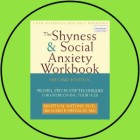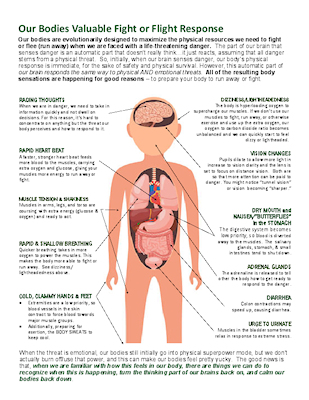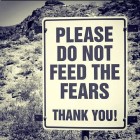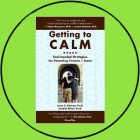All Posts in Category:Anxiety/Depression
Shyness and Social Anxiety Workbook: Proven, Step-by-Step Techniques for Overcoming your Fear by Martin M. Antony PhD and Richard Swinson MD FRCPC FRCP share
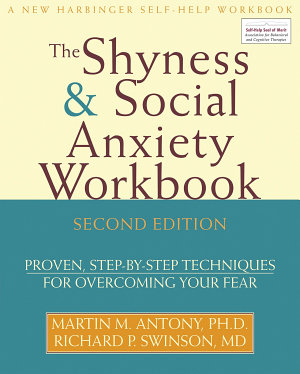 I recommend using this book when working with adults and some teens who have high levels of shyness and social anxiety. In a clear, and easy to read fashion, this book takes you step-by-step through the process of learning about how cognitive behavioral therapy (CBT) views shyness and social anxiety and is a powerful tool in overcoming how these thoughts and feelings can hold you back from living your life in a way that you are comfortable and happy with. CBT is a therapeutic philosophy and a large body of scientific research strongly supports CBT as the foremost treatment of social anxiety.
I recommend using this book when working with adults and some teens who have high levels of shyness and social anxiety. In a clear, and easy to read fashion, this book takes you step-by-step through the process of learning about how cognitive behavioral therapy (CBT) views shyness and social anxiety and is a powerful tool in overcoming how these thoughts and feelings can hold you back from living your life in a way that you are comfortable and happy with. CBT is a therapeutic philosophy and a large body of scientific research strongly supports CBT as the foremost treatment of social anxiety.
I do think that most people would still need a therapist to be guiding them through the process because for the individual working to learn these skills and challenging themselves to try new things, it can take a lot of energy. When a therapist is coaching you in the sidelines (and celebrating your successes with you), it frees you up to devote all of your energy towards growing. However, over time, these are skills that you will learn and can take with you forever. Once you understand how it works and how powerful it is, you will be able to use this approach to tackle any similar issues that should come up for you in the future.
As a therapist, I don’t use this book alone. I supplement it with concrete, scientifically grounded information about relaxation breathing, Growth Mindset as well as other customized handouts and tally sheets for homework.
Panic Attacks Part 1: What is Panic & Why We Need It share
Panic is a normal, necessary physical response to the brain perceiving a significant threat. It involves the release of a hormone that you are likely familiar with, adrenaline. Adrenaline’s job is to tell the body to make chemical changes in the body so that the body is physically primed to either fight or flee/run away, from the threat. These can be things such as:
- Rapid heartbeat
- Short, shallow breaths
- Paling or flushing (can switch between both)
- Digestion slows down or stops (becomes a low priority for your body)
- Constriction of blood vessels in many parts of the body…including the BRAIN (which interferes with your ability to think logically)
- Dilation of blood vessels for muscles (so they are ready for action)
- Take energy from stored nutrients to fuel muscles
- Dilation of pupils
- Temporary loss of hearing
- Tunnel vision (loss of peripheral vision)
- Physical shaking

Back in the day of the caveman, the people who didn’t have a panic response were much less likely to survive because their bodies were not as prepared to deal with a physical threat. Our body’s ability to quickly maximize all of our resources for survival is a critical aspect not only of humans but all animal species. Yet, in our Western culture, many of us are fortunate that our safety is not regularly threatened in a physical way. Instead, because our brain does not recognize a difference between a physical threat and emotional threat, in a modern society a panic response can often be triggered by things such as fear of embarrassment or fear that a bridge might collapse. Or, perhaps you do have experience with your physical safety being at risk and now, your body is in hyper-vigilant mode and looking for danger at every corner.
The problem here is that our body’s physical readiness to fight or run won’t help us to not be embarrassed. Nor will it help us cross a perfectly well-maintained bridge or walk around the corner in a typically safe neighborhood. Instead, that physical response can feel scary itself and physically uncomfortable if we don’t do anything to burn off that energy and bring our body back to calm. Additionally, increasing our breathing rate without making use of the extra oxygen we are taking in creates a chemical imbalance between the oxygen and carbon dioxide levels of our body that adds to our feelings of physical discomfort.
So, what can we do if we start to physically panic about a possible emotional threat? Check out the next article in this series!
Remaining articles in this series:
- Panic Attacks Part 2: The Antidote to Panic – Relaxation Breathing
- Panic Attacks Part 3: Fear of the Fear – Don’t Let Panic Attacks Take Over Your Life
- Panic Attacks Part 4: Time To Tune Into Your Early Warning System (coming soon)
Panic Attacks Part 2: The Antidote to Panic - Relaxation Breathing share
Previous article in this series:
- Panic Attacks Part 1: What is Panic & Why We Need It
Relaxation breathing is the antidote to panic. Literally. It is impossible to be truly breathing in a relaxed way and to be experiencing a full-blown panic attack at the same time. This is because relaxation breathing helps to reset our body chemistry to a “normal” state and bring it out of panic. If you haven’t read it yet, the previous article in this series, Panic Attacks Part 1: What is Panic & Why We Need It, you might want to check it out.
Some people may tell you that there is a “right way” to do relaxation breathing. In my opinion, if you try the “right way” and you find it to be really annoying and just plain won’t do it, then clearly that is not the right way for you. Generally, the recommendation is that you are breathing out for a longer count than you are breathing in and that you are taking in air by expanding your belly muscles, not your chest muscles.
My recommendation is that you find something that feels comfortable for you and go with that approach. No matter which approach you choose, the most important thing is that you practice relaxation breathing every day when you are already calm. I cannot stress this point enough. When your body is in panic mode, learning a new skill is not something that your brain is going to be very good at. So if you’re heading into a panic attack and you haven’t been practicing your relaxation breathing, don’t be surprised if it doesn’t work to help you return to calm…yet.
Regardless of the breathing technique that you decide to use, I recommend that you practice your relaxation breathing during a time that you are already relatively calm and relaxed, for five minutes at a time, a minimum of 1-2 times every day, with one of those times being at night when you are lying down to fall asleep. The main goal is to be able to clear your mind of all thought and just focus on the sensation of your breath going in and out of your body. Or, you can add some sort of positive phrase that you can repeat to yourself if it helps. (For example: “Breathe in calm. Breathe out fear,” but it could be anything so long as you interpret it as positive and relaxing.)
Below is a video that describes square breathing and then, below that, a few other informational links. The video is geared towards kids but you can use whatever imagery you like, and, who doesn’t enjoy the smell of fresh baked cookies?? (You’ll understand that last comment when you watch the video.)
Additional Breathing Information:
- Another take on square breathing, including a printable that you can download and customize.
- Diaphragmatic breathing, also known as “belly breathing,” which can be blended with square breathing if you’d like.
If you have a smart phone, there are also plenty of free apps that you can download to help coach you through relaxation breathing. Here are two that I’ve had experience with:
- Breathe2Relax – availabe on iPhone and Android (I recommend adjusting the default settings to what is comfortable for you.)
- Centered – available on iPhone only 🙁
Remaining articles in this series:
- Panic Attacks Part 3: Fear of the Fear – Don’t Let Panic Attacks Take Over Your Life
- Panic Attacks Part 4: Time To Tune Into Your Early Warning System (coming soon)
TED Talk - What Fear Can Teach us presented by Karen Thompson Walker (video) share
Dan Zadra says (according to the internet), “Worry is a misuse of imagination.” So it seems to be a logical extension of that idea to say that we worry most about the things that are easiest to imagine. In this TED talk, Karen Thompson Walker cites history and scientific research to assert that this is indeed the case. Knowing this has the potential to help us make more informed and practical decisions…if we strive to focus on facts and not the lurid details that our brains can conjure. It can also help us short-circuit our brain’s inclination to borrow trouble and leave us marinating in the anxiety of what is possible, rather than what is probable. When we recognize our fears for what they are, a story that our mind is creating about what could possibly happen, after taking a logical look about whether the fear is something truly worth worrying about, we can choose to give less importance to some of the scary stories that our brains can distract us with.
PS – If anyone has a reliable citation for the quote above, please let me know!
Panic Attacks Part 3: Fear of the Fear - Don't Let Panic Attacks Take Over Your Life share
Previous articles in this series:
- Panic Attacks Part 1: What is Panic & Why We Need It
- Panic Attacks Part 2: The Antidote for Panic & Relaxation Breathing
Panic attacks feel very intense when you have them. At best, it’s not a comfortable feeling. At worst, it feels very scary because your body feels like it’s out of control. Some people even worry that they are having a heart attack. If you are experiencing these symptoms for the first time, definitely talk with a medical professional to rule out any medical causes before treating the symptoms as a panic attack. This is important for two reasons. The first is that you need to get a proper diagnosis. The second is that if you are constantly worrying that you are having a heart attack…that’s going to increase your anxiety and make successfully treating panic very difficult.
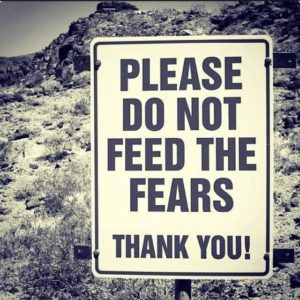 Once you know that your body is healthy and ok, it’s time to dig in to the emotional aspects that come into play with panic and anxiety. When you worry too much about the possibility that you might have a panic attack, then this worry itself can become the trigger for your next panic attack. I call this having “fear of the fear (that it will happen again).” With the use of acceptance, information, “growth mindset,” and skill development, here are some guidelines that work against the negative spiral that can happen when people start to develop a “fear of the fear.” This article assumes that you already have started working on developing the skills for turning around a panic attack and is part 3 of a four-part series of articles I hope to complete. Hopefully, I’ll get part 4 up soon!
Once you know that your body is healthy and ok, it’s time to dig in to the emotional aspects that come into play with panic and anxiety. When you worry too much about the possibility that you might have a panic attack, then this worry itself can become the trigger for your next panic attack. I call this having “fear of the fear (that it will happen again).” With the use of acceptance, information, “growth mindset,” and skill development, here are some guidelines that work against the negative spiral that can happen when people start to develop a “fear of the fear.” This article assumes that you already have started working on developing the skills for turning around a panic attack and is part 3 of a four-part series of articles I hope to complete. Hopefully, I’ll get part 4 up soon!
- Recognize that this is a new situation for you and, because of that, it makes sense that it’s hard in the beginning to figure out what’s happening and how best to manage it. Also, know that you’re not alone. There are many people who have or are currently going through this too.You are having, what is called, a panic attack. [Growth Mindset]
- Remember that fight or flight mode is a normal thing that our bodies do. The only problem is that it’s getting triggered when you don’t actually need to respond physically to an emotionally stressful situation. The most important thing to know here is, NO HARM WILL COME TO YOUR BODY AS YOU EXPERIENCE IT (your body physically revving up to fight or flee). It does feel yucky to be in physical panic mode. This is especially true because your body, in that moment, is primed with an abundance of energy to physically react and that means that you experience temporary physical changes to your body (i.e. increased heart rate, quick & shallow breathing, increased blood circulation to muscles, decreased blood circulation to the “rational” part of your brain, and more), but your body naturally knows how to shift out of this mode when the perception of a physical threat is gone. [Watch this great video about how the US government has learned to train Navy SEALS not to panic.]
- Accept that this is not your last panic attack. What I’m saying here is find a way to be ok with knowing that it will happen again AND that should one happen and your growing relaxation and cognitive skills can’t turn it around, you can ride it out until it’s done and be still be ok. In general, the goal is for the panic attacks to start reducing in intensity as you get better at turning them around but this won’t happen if you avoid panic attacks, or things that might cause them, rather than face them. [Acceptance]
- Continue to experiment with and practice various relaxation techniques (relaxation breathing is the most important one for panic) and good self care habits so that you can hone your skills and have more “tools” in your “toolbox” when the need arises. [Skill Development]
- Work on developing cognitive strategies that can help prevent panic attacks from happening or intervene at the early signs of panic so that you can prevent a full blown physical response. [Skill Development]
- Keep a list of things that help turn your panic attacks around so that you can refer to the list the next time. [Skill Development]
- Remembering that low blood sugar, hypoglycemia, can mimic the beginning feelings of a panic attack, carry a healthy snack with you that has a nice combination of protein and complex carbs. [Check out this podcast by Dr. Kristen Allot about why this is so incredibly important.]
- Minimize or, ideally, eliminate caffeine. Drink water. Enjoy water. Did I mention water? [Information]
Remaining article in this series:
- Panic Attacks Part 4: Time To Tune Into Your Early Warning System (coming soon)
The Effect of "Power Posing" Likely Depends on Context and Our Thoughts share
 I had mentioned Amy Cuddy’s work about power posing to a similarly scientifically-minded person recently and, after doing some reading on their own, they brought to my attention a blog article posted on the Scientific American website, The Dark Side of Power Posing: Cape or Kyrptonite, by Jay Van Bavel (11/212013). It took a look at Amy Cuddy’s work about ‘power posing’ and then pulled in some other relevant research findings. Basically, research suggests that there are traits within us and within our environment that affect whether power posing is helpful or makes things worse. One study found that, if you are a person who struggles with a lot of negative self-talk, power posing can actually have the opposite effect and decrease self-confidence. Other studies suggest that power posing can also be used to increase the likelihood of us doing things that amount to an abuse of power, such as: steal; cheat; or break traffic rules.
I had mentioned Amy Cuddy’s work about power posing to a similarly scientifically-minded person recently and, after doing some reading on their own, they brought to my attention a blog article posted on the Scientific American website, The Dark Side of Power Posing: Cape or Kyrptonite, by Jay Van Bavel (11/212013). It took a look at Amy Cuddy’s work about ‘power posing’ and then pulled in some other relevant research findings. Basically, research suggests that there are traits within us and within our environment that affect whether power posing is helpful or makes things worse. One study found that, if you are a person who struggles with a lot of negative self-talk, power posing can actually have the opposite effect and decrease self-confidence. Other studies suggest that power posing can also be used to increase the likelihood of us doing things that amount to an abuse of power, such as: steal; cheat; or break traffic rules.
I found Van Bavel’s article very interesting because, after I learned about Cuddy’s work, I had been curious about how it connects to the scientific research about the power of positive mental imagery. Research in the area of sports psychology has found a significant connection between athletes mentally rehearsing their craft and improvement in their ability to perform the tasks their sport requires. And trauma research has revealed that healing can take place when we re-imagine a traumatic event and role-play ourselves as powerful and able keep ourselves safe. So, after learning about how power posing affected body chemistry, I had wondered if simply imagining a power pose could shift body chemistry as well.
Because Van Bevel’s ‘Dark Side’ article is generally talking about the importance of our thoughts when we strike a pose, that what we are thinking affects whether we can use poser posing for ‘good’ or for ‘evil,’ it leads me to suspect that our body chemistry does change when we imagine ourselves doing a power pose. Hopefully, a researcher will take a look at that in the near future. More importantly, though, the notion that our thoughts can influence whether a power pose is a good thing, suggests to me that pairing the power pose with positive self-talk is critical so that we can increase the likelihood of using our power for the good of ourselves and for society in general. The next time you are doing your Wonder Woman pose before your next job interview, I would suggest that you are also imagining yourself speaking to the interviewer in a confident and personable way.
TEDx UC Davis: Getting Stuck in the Negatives (and how to get unstuck) presented by Alison Ledgerwood, PhD (video) share
Dr. Ledgerwood’s research show us that our brains are hardwired to subconsciously focus on negative information, despite positive information to the contrary. However, when we make a conscious decision to shift our focus to positive things…things that are already there but our brains just having been paying attention to them, we can change our view of the world and of ourselves.
TEDx Talk: Feeling Good presented by David Burns, MD share
Cognitive Behavioral Therapy (CBT) is based on the premise that our thoughts, emotions, and behavior are all interrelated and affect one another. Because of this, if we learn to identify when we are having “thought errors” that distort our perception of reality, often skewing to seeing things in more a negative light, we can then Dr. David Burns is a well known researcher, clinician, and public speaker. He is one of the leaders in the development of CBT, having been trained personally by CBT’s founder, the world-renowned Aaron T. Beck, MD. In this short video, Dr. Burns uses stories from his life experience both as a clinician and as a person, to illustrate the power of CBT and how working to change our thoughts, in a real and genuine way, can have a profoundly positive effect on how we feel. CBT has become the strongest (most likely to succeed), “evidence-based” form of therapy for issues such as depression and Bipolar Disorder, various forms of anxiety (PTSD, phobias, Obsessive-Compulsive Disorder), eating disorders, and substance use disorders. This means that scientific research has been able to document that CBT really works for people.
Getting to Calm: Cool-Headed Strategies for Parenting Tweens + Teens by Laura S. Kastner PhD & Jennifer Wyatt, PhD share
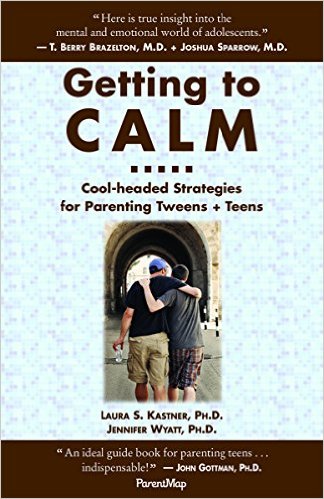 I intend to get around to reading this myself. My “to read” book pile is quite high at the moment. So many wonderful ideas, so little time! However, on surface glance, it appears that it would be a quality resource to recommend to parents who are in the throws of struggling with their excessively moody teen.
I intend to get around to reading this myself. My “to read” book pile is quite high at the moment. So many wonderful ideas, so little time! However, on surface glance, it appears that it would be a quality resource to recommend to parents who are in the throws of struggling with their excessively moody teen.
I am a fan of Dr. Kasner’s, after seeing her speak in a YouTube video, that I highly recommend. She does a wonderful job of weaving what science now tells us about the teen brain into a cohesive approach to parenting teens.

